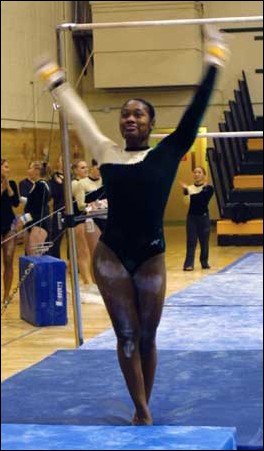Coleman vaults past competition

Image: Coleman vaults past competition:Hornet junior Binta ColemanPhoto by Margaret FriedmanState Hornet:
February 5, 2003
Binta Coleman, her hands covered in chalk and wrapped in leather safety straps, has just finished her practice routine on the uneven bars.
She slaps her hands together coughing up dust, and glances over at the cartwheeling preschoolers who share her practice space. The kids are not much younger than Coleman was when she started taking gymnastics classes.
Looking back and forth from the tumbling preschoolers to Coleman, is like looking at a before-and-after photo that advertises 17 years of physically demanding gymnastics training and grueling self-sacrifice.
“My mom got me started in gymnastics classes when I was six, and I’ve been competing ever since I was 10 years old,” said Coleman, a junior civil engineering major and the scoring leader on the promising, yet injury-plagued Sacramento State gymnastics team. “It’s something that I eventually grew to love.”
Gymnastics has dominated Coleman’s life ever since she was a pig-tailed preschool tumbler herself, and she’s returned the favor by dominating her competition.
In the team’s Jan. 26 meet against Cal State Fullerton, Coleman placed first in three different events, although the Hornets ended up narrowly losing the meet.
Besides being the team’s individual scoring leader, Coleman, according to her coaches, is the Hornets’ top “all-arounder.” As an all-arounder she competes in the vault, the balance beam, the uneven bars and the floor exercise.
With the team’s other top gymnasts, Toni Petersen and Stefanie Aeder sidelined by season-ending injuries, Coleman holds more than chalk and leather in her hands; she may hold the fate of the Hornets’ entire season.
“With Toni being out, Binta is our top competitor,” 25-year head coach Kim Hughes said. “She sets the example on training and on having that competitive edge. Having girls out with injuries makes her stand out even more.”
Coleman claims she doesn’t feel any extra pressure to perform because of the injuries.
“In gymnastics, we’re scored as a team, so the whole team feels the pressure, not just one person,” she said.
Still, Coleman admits that the team’s diminished depth places the responsibility to “come through” on her shoulders.
The Sac State media guide lists Coleman at 5-foot-6, pretty lengthy for a gymnast but not necessarily tall.
However, she appears to tower over her relatively smaller teammates. Her powerful physique is more reminiscent of Serena Williams than Kerri Strug.
Of all the Hornet gymnasts, Coleman’s body most readily reveals the effects of the 20 hours of practice time per week. Twice-weekly weightlifting and off-season sprinting, swimming and aerobic workouts are required to remain competitive in the world of gymnastics.
“When you think gymnastics, you don’t necessarily think of Binta,” said CSUS assistant coach Randy Solorio, who started working with Coleman 17 years ago at Byers Gymnastics Center.
“She’s always been powerful, but she’s gotten even stronger in the upper body as she’s gotten older,” he said. “Everything she does is big, and that’s what makes her so special.”
Hughes feels Coleman’s strength is just a piece of her arsenal.
“Most people think of female gymnasts as tiny and petite, but Binta has a quality of strength and power, while also remaining graceful,” Hughes said. “She’s a good showperson with a lot of flair.”
Even at a young age it didn’t take long for Coleman’s flair to catch fire.
After nearly a decade of childhood training and competition, the Elk Grove native went on to compete for the Laguna Creek High gymnastics team, where she finally started to realize her true potential.
“It wasn’t until my coaches started talking about getting gymnastics scholarships that I realized how good I could be,” Coleman said. “That really lit a fire under me to train harder.”
Unlike most of her classmates, Coleman barely glanced at a television throughout high school and college.
Because Coleman attended a local high school, Hughes and his coaches had a unique opportunity to scout the gymnast for Sac State.
“We knew her abilities and had been watching her compete for a while,” Hughes said. “She was one of the top high school senior athletes out there and we were lucky to recruit her.”
Despite the team’s injuries and setbacks, Coleman remains optimistic about the team’s chances for the 2003 season.
“We’ve still got a long way to go,” Coleman said. “We know what we can do because we’ve been doing it in practice. It’s just a matter of doing it in front of the judges.”
Unlike her injury-bitten teammates, Coleman has never suffered any major gymnastics-related injuries, a lucky streak in any competitive sport.
But this past week, Coleman was unable to compete in the Hornets’ meet at UC Davis due to a sprained ankle which will keep her out for two weeks.
She is expected to make her return on Feb. 16 when the Hornets take on San Jose State at Hornet Gym.
“Getting hurt is always a threat, but it’s not something I wake up in the middle of the night thinking about,” she said.
As Coleman’s college career begins to wind down, Hughes believes she’ll have to start looking beyond gymnastics.
“Being a gymnast requires quite a unique dedication, and there’s a lot of sacrifice that goes on,” Hughes said. “But once their college career is done, so are they.”
“They’re not going to train 20 hours a week or compete in meets anymore, and that can be a difficult transition.”
Hughes tries to get his graduating gymnasts involved in other physical activities in order to ease the passage.
Although Coleman is rapidly approaching her graduation date, she’s still not sure what she wants to do after school ends.
However, she’s starting to look forward to life after gymnastics training and competition.
“After gymnastics is over, I’ll be able to focus solely on school,” Coleman said. “I’ll be piling on the units and trying to graduate as soon as possible.”






















































































































